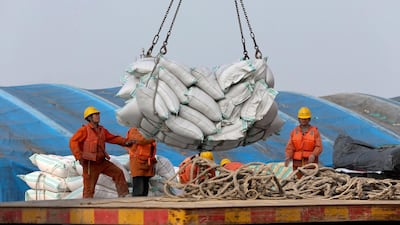China said it would levy 25 per cent tariffs on imports of 106 US products including soybeans, automobiles, chemicals and aircraft, in response to proposed American duties on its high-tech goods.
Matching the scale of proposed US tariffs announced Tuesday, the Ministry of Commerce in Beijing said the charges will apply to around $50 billion of US imports. The step ratchets up tension in a brewing trade war between the world’s two largest trading nations, with the Trump administration’s latest offensive based on alleged infringements of intellectual property in China.
In a statement released Wednesday, China’s envoy to the WTO, Zhang Xiangchen, said that a list of planned charges on more than 1,300 product categories focused on its industrial machinery and technology exports was "an intentional and gross violation of the WTO’s fundamental principles of non-discrimination and bound tariffs."
In deciding which products to hit, US officials on Tuesday identified product lines that the US Trade Representative’s office says benefit unfairly from government industrial policies, including Beijing’s Made in China 2025 plan to to dominate key strategic technologies.
In targeting sectors that Beijing is openly trying to promote, the US is signaling that its strategic aim in the current conflict is preventing China from gaining the global technological leadership that it wants. That has provoked anger in China, while analysts voiced doubt that the tariffs will succeed in changing Beijing’s behaviour.
The tariffs may have only a minor economic impact, increasing levies by $12.5bn on Chinese shipments to the US that reached $506bn last year, said Shane Oliver, the head of investment strategy at AMP Capital Investors in Sydney. That’s an average tariff increase on overall imports from China of just 2.5 per cent, he said.
"The main risk is that China’s response leads to a counter retaliation by the US and a process of escalating tariffs that leads to a sharp slowing in trade between the two countries," said Mr Oliver.
Asian stocks were mixed as traders awaited a more detailed response from China to the latest escalation of trade tensions between the world’s two largest trading nations. The Shanghai Composite Index rose.
_________________
Read more:
US tariff proposals target Chinese tech
Trump has one thing right, America is not great alone
_________________
Industries including aerospace, information and communications technology, robotics and machinery are among those targeted by the USTR on Tuesday, which said it also chose products to minimize the impact on the US economy and consumers.
In addition to advanced technologies such as communication satellites, the list includes things ranging from various types of steel to television components, medical devices, dishwashers, snow blowers and even flame throwers.
"The US has this vicious intention to strangle China’s high-tech innovation," said Wei Jianguo, former vice commerce minister and now an executive deputy director of the China Center for International Economic Exchanges, a government-linked think tank. "China won’t submit to the US bully. Our countermeasures will hit their soft spots."
The US duties will likely provoke a strong response from China, said Carlos Gutierrez, US commerce secretary under former President George W. Bush.
“Wars start with battles, and the battles have started,” Mr Gutierrez, co-chair of the consulting firm Albright Stonebridge Group, said in an interview in Mexico City. Chinese President Xi Jinping “can’t afford to look like he’s getting pushed around.”
The release of the list by US Trade Representative Robert Lighthizer leads into a roughly 60-day period when the public can provide feedback and the government holds hearings on the tariffs. The 25 pecent tariffs come on top of any existing levies.
China’s Made in China 2025 plan was announced in 2015, and highlighted 10 sectors for support on the way to China becoming an advanced manufacturing power, from information technology, to robotics and aerospace. In addition, China has a separate development strategy for artificial intelligence, published in 2017.
USTR said the public can submit written comments on the tariffs until May 11, and it will hold a public hearing on them on May 15 in Washington.

